While other districts, such as El Poblado and Laureles, are famous as the best areas for tourists in Medellín, the City Center offers a fascinating glimpse into the city’s pulse and historical evolution.
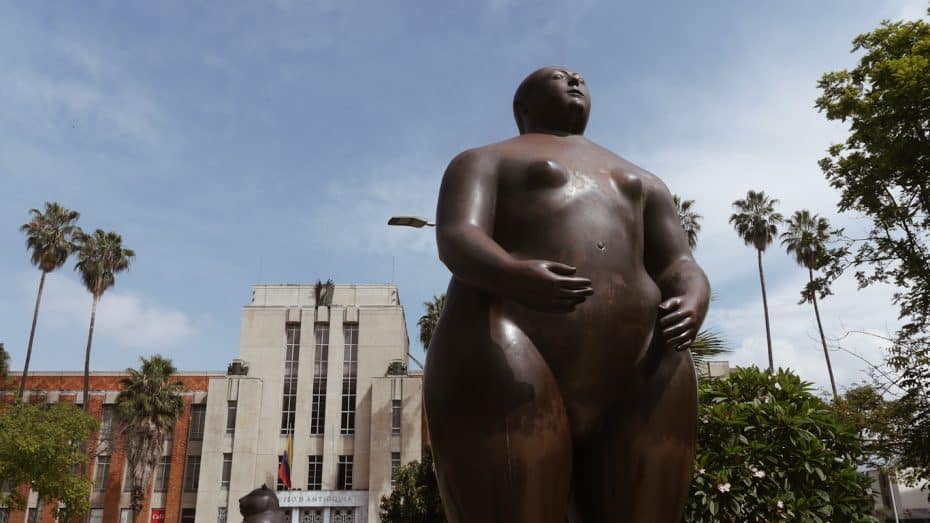
Medellín’s city center is known locally as “El Centro.” It includes important areas like historic La Candelaria and the La Alpujarra Administrative Center, a hub for government buildings.
Historically, this district has massively evolved from its early days in the 17th century, when Medellín was officially founded. Centro has grown to become the economic and cultural heartbeat of the metropolis. These are some things to see and do in Medellín City Center.
Medellín City Center: A Brief History
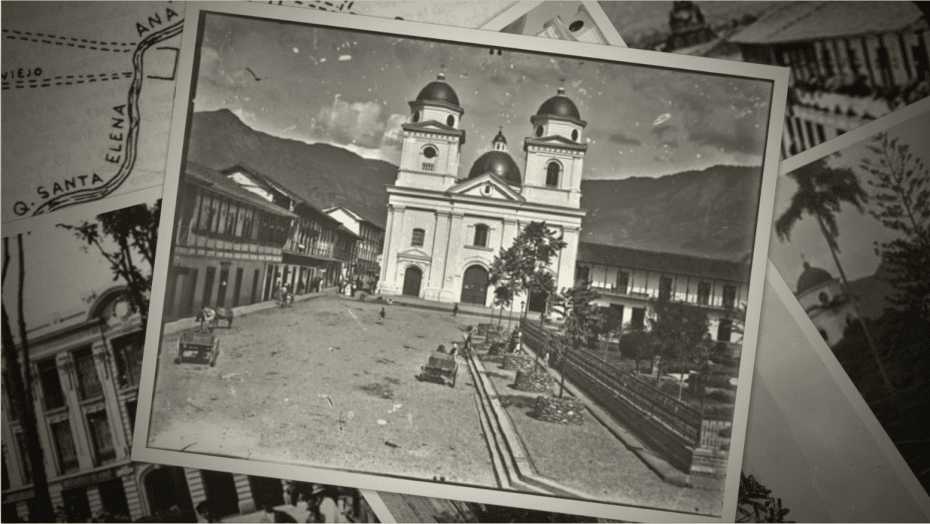
Medellín, Colombia’s second-largest city (after the capital city of Bogotá), has a vibrant history of resilience and transformation. The city center, known as El Centro, has been the focal point of this evolution. Originally established in 1616 by Francisco Herrera Campuzano under the name of El Poblado de San Lorenzo, the area became known as Villa de Nuestra Señora de la Candelaria de Medellín in 1675.
During the 19th century, Medellín grew significantly due to its strategic location as a trade center. The economic boom brought about by coffee production catalyzed urban development. Landmarks such as the Metropolitan Cathedral (Catedral Basílica Metropolitana) were built during this period. Built from 1875 to 1931, it stands as one of the largest brick-built churches in the world.
The early 20th century saw a continuation of this growth with industrialization and infrastructural advancements. Landmark structures such as Edificio Carré and Edificio Coltejer were erected during this time, symbolizing early-modern architectural progress. Plaza Botero later became a cultural hub after being revitalized in the late 20th century, featuring sculptures by local artist Fernando Botero.
However, the latter part of the 20th century was tumultuous for Medellín due to political instability and the influence of drug cartels. The assassination of political figures and widespread violence during Pablo Escobar’s dominance in the 1980s and early ’90s left deep scars on Medellín Centro.
The city’s renaissance began in the early 21st century with strong local governance focusing on public projects and community engagement. Iconic transformations include Parque Berrío and Parque San Antonio. Now, centers for socialization and culture.
Today, El Centro is moving towards becoming a safer, more inclusive space while retaining its historical essence. Significant locations like Palacio de la Cultura Rafael Uribe Uribe and Museo de Antioquia offer insights into Medellín’s complex yet compelling history.
Must-Visit Attractions in Medellín City Center
Medellín’s city center is a dynamic area bustling with energy and culture. Here, modern skyscrapers meet colonial-era and Republican buildings. These are some of the top attractions to see and things to do in El Centro.
1. Plaza Botero
Av. Carabobo, La Candelaria
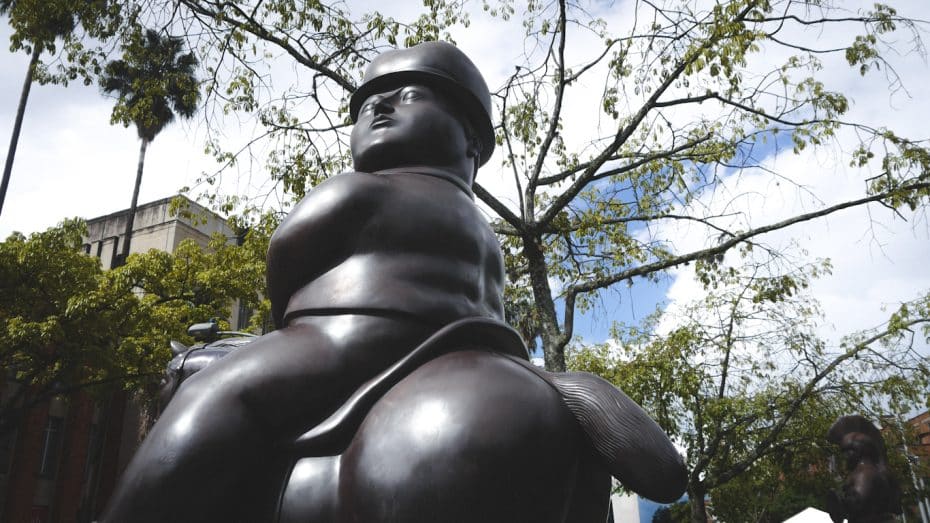
Plaza Botero, located in the heart of the Centro area of Medellín, is a public square filled with sculptures by the famous Colombian artist Fernando Botero. The plaza features 23 sculptures donated by the artist himself.
In case you missed it…
Plaza Botero’s history is intimately connected with the artist. Fernando Botero, born in Medellín in 1932, is celebrated for his distinctive style of depicting people and objects in exaggerated volume. This style has become iconic and is easily recognizable worldwide. His works are a tribute to his hometown.
Some of the notable sculptures include “The Hand,” “Adam and Eve,” “Woman with Fruit,” “The Dog,” “Man on Horseback,” and “Maternity.”
Additionally, the plaza is directly opposite the Museo de Antioquia, which houses a large collection of Botero’s works.
Conveniently, Plaza Botero is easily accessible from different parts of Medellín via Line A of Metro de Medellín. The nearest station is Parque Berrío. From there, it’s just a short walk to the plaza. Multiple bus routes and taxis are also available.
2. Museum of Antioquia
Cl. 52 #52-43, La Candelaria
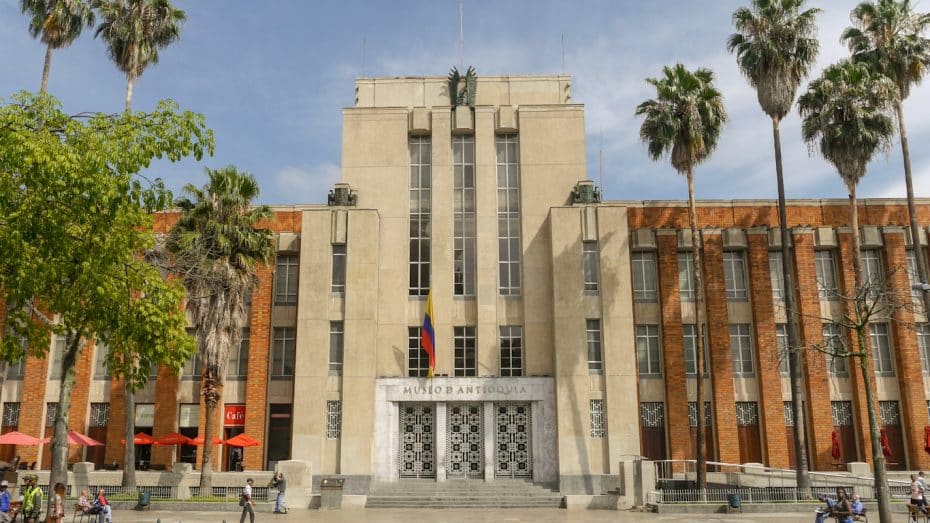
Located at Plaza de Botero, the Museum of Antioquia is deeply rooted in Medellín’s cultural fabric. Established in 1881, it’s the second-oldest museum in Colombia.
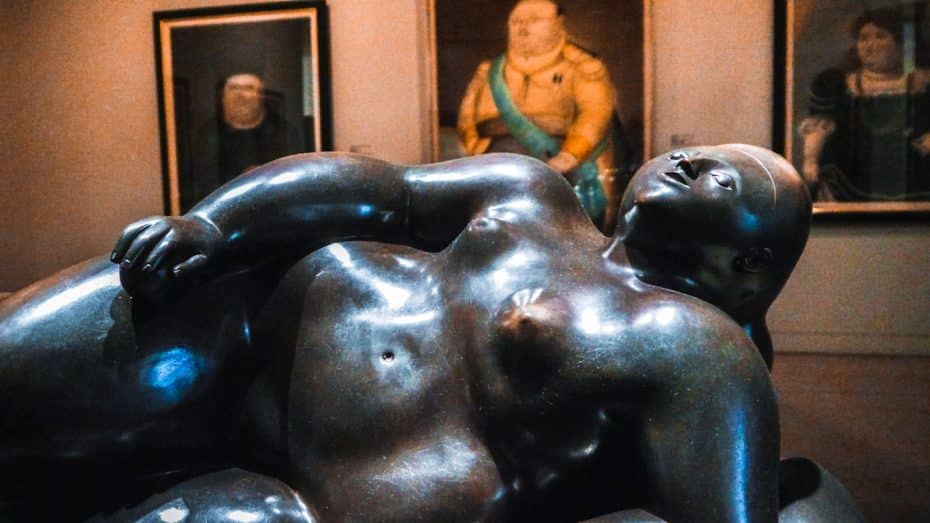
Museo de Antioquia showcases an extensive collection of Latin American art, including works by Medellín native Fernando Botero, whose exaggerated and voluptuous figures have gained international acclaim.
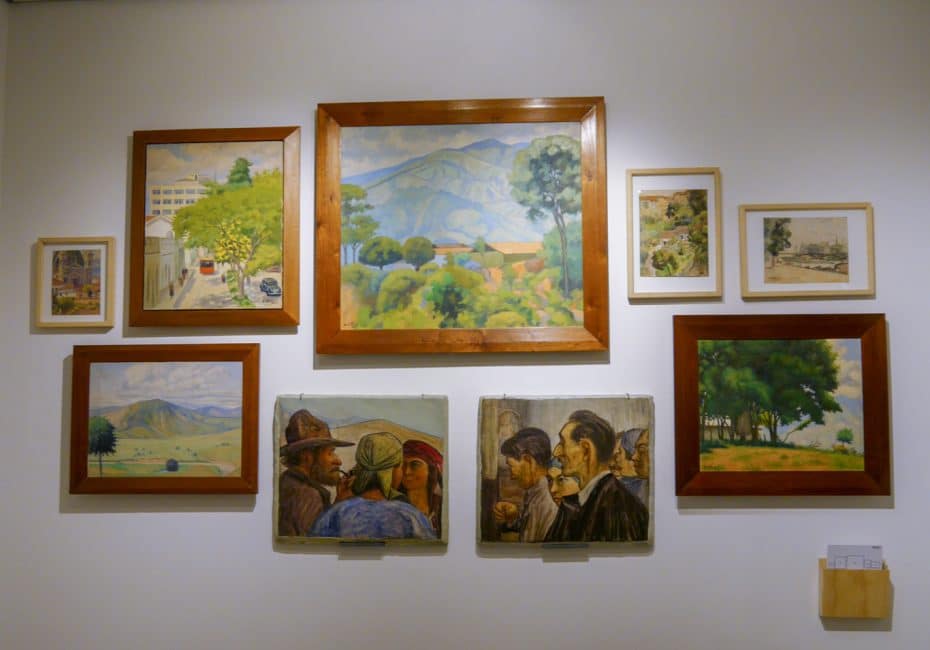
Other notable artists include Pedro Nel Gómez and Eladio Vélez from Colombia depicting landscapes, as well as industrial and social themes. The museum also houses works by Francisco Narváez, a Venezuelan artist known for his modernist stone carvings, and Alejandro Obregón, a Colombian painter whose works often feature dramatic volatility and expressive abstraction.
In case you missed it…
The museum also features contemporary Latin American photography exhibits. On the first floor, you’ll find a dedicated space for temporary exhibitions that rotate throughout the year.
You can take Medellín’s Metro system to reach the Museum of Antioquia. The closest metro station is Parque Berrío on line A. From there, it’s a short walk to Botero Plaza, where the museum is. Bus lines that pass through this area also connect various parts of the city.
3. Plaza Cisneros (Parque de las Luces)
Cl 44, La Candelaria, Medellín
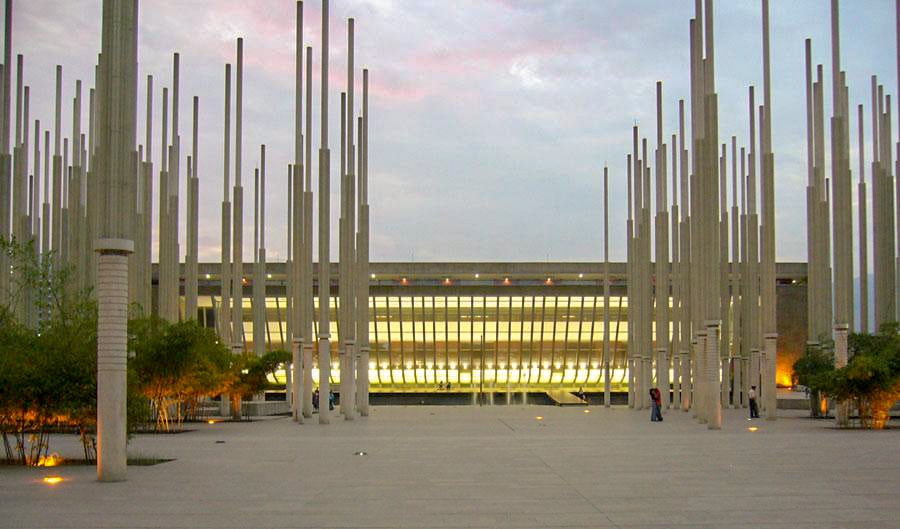
Plaza Cisneros, also known as Parque de las Luces, is located in the La Candelaria neighborhood of the city’s downtown area. It was inaugurated on December 18, 2005, as part of an urban renewal project to revitalize the once-neglected area.
The plaza spans a large open space featuring several vertical light poles, which create an impressive visual effect, especially at night. Each pole stands approximately 24 meters (78 ft) high and includes lighting that gives the park a modern appearance.
The plaza’s design is an allegory to the city’s path to a brighter future.
In addition to its striking illumination features, Plaza Cisneros incorporates green spaces. Noteworthy attractions nearby include the EPM Library and the Vasquez and Carré buildings.
Plaza Cisneros is easily reachable through Medellín’s Metro system. Line A San Antonio Station and Line B Cisneros Station are within walking distance from the plaza.
4. Berrío Park
La Candelaria, Medellín
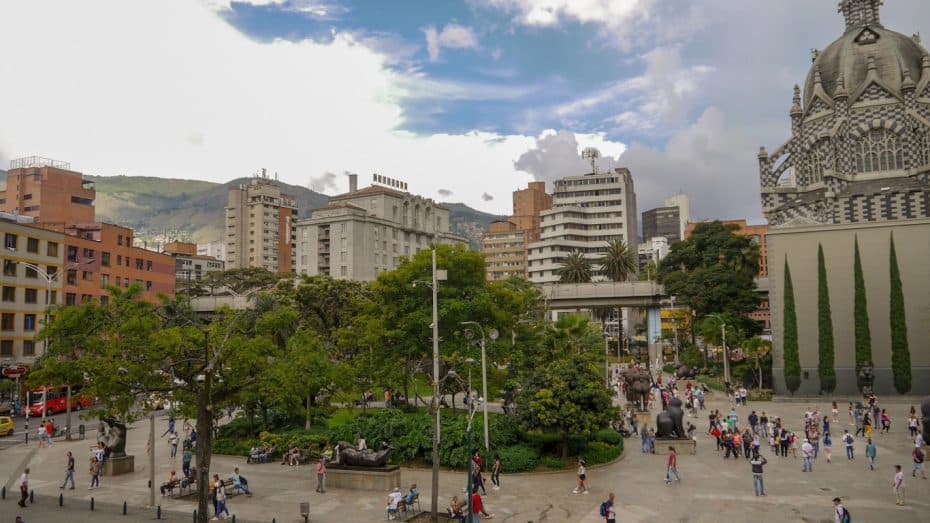
Berrío Park was originally founded in 1646. It’s named in honor of General José Jerónimo Berrío, who contributed significantly to the development of Medellín during the early 20th century.
Renowned for its iconic architecture and green spaces, Berrío Park is a must-visit destination. The area’s main attractions include the Metropolitan Cathedral, Palacio de la Cultura Rafael Uribe Uribe, and the Antioquia Museum.
The park is easily accessible via public transport. To visit Berrío Park, take the Medellín Metro system’s Line A and get off at the Berrío Station.
5. Palacio de la Cultura Rafael Uribe Uribe
Carrera 51 #52 01 Medellín
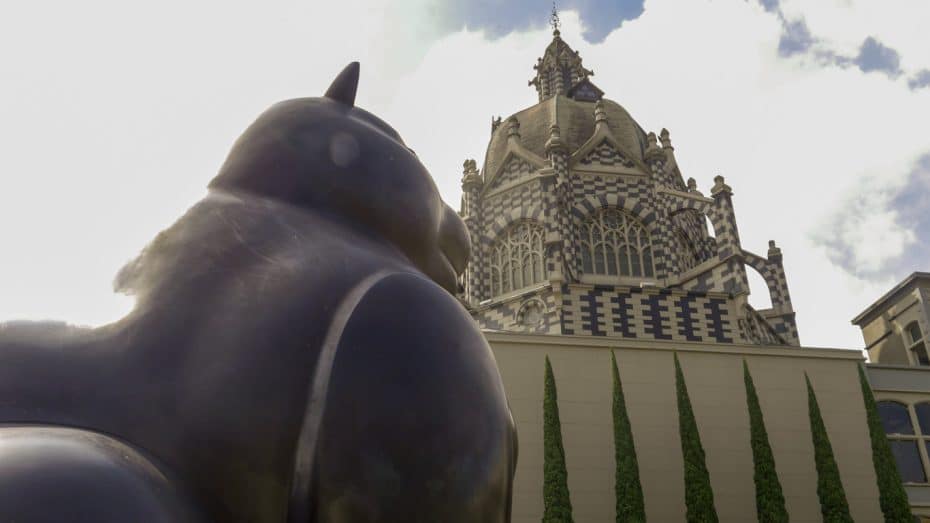
The Palacio de la Cultura Rafael Uribe Uribe is an iconic building that stands out for its historical European style.
Built between 1906 and 1930, this architectural masterpiece was designed by Belgian architect Agustin Goovaerts. Initially intended to serve as the city’s municipal palace, it was named in honor of Rafael Uribe Uribe, a prominent general and politician.
The building’s eclectic style, anchored by neo-Gothic elements, makes it stand out prominently against the city’s skyline. Inside, the structure houses the Departmental Archive of Antioquia, a gallery that regularly hosts art exhibitions and a small museum dedicated to the region’s history.
The Palacio features stunning stained glass windows and an intricate stone façade. Its inner courtyard provides a serene spot amid the bustling city.
To visit the Palacio de la Cultura Rafael Uribe Uribe, you can take Medellín’s metro system. The closest station is Parque Berrío on Line A.
6. Catedral Basílica Metropolitana
Cra. 48 #56 – 64, La Candelaria, Medellín
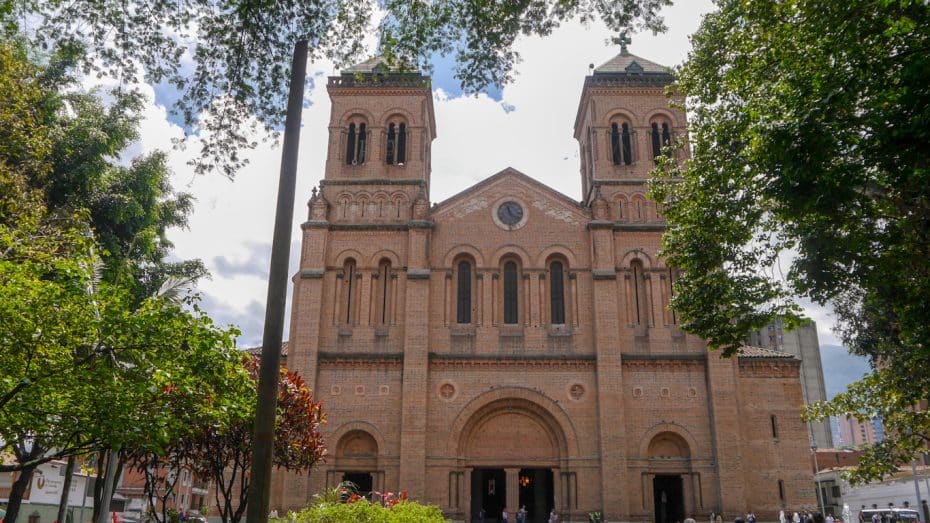
Officially known as Catedral Basílica Metropolitana de la Inmaculada Concepción, Medellín’s Cathedral is one of the top attractions in the downtown area.
Although it looks much older, it was actually completed in 1931. Today, it is one of the largest brick-built churches in the world and stands out for its Neo-Romanesque architectural style. The cathedral was originally designed by French architect Charles Émile Carré and took around 55 years to finish.
Located in the Villanueva neighborhood in the center of Medellín, it occupies an area on Carabobo Street and Bolívar Park. The cathedral features two towers, each rising to 66 meters (216 ft) and a length of 72 meters (236 ft). Its interior features beautiful stained-glass windows created in Spain, fine woodwork, marble sculptures, and a large pipe organ from Germany.
Additionally, the cathedral holds a bronze crucifix, numerous religious paintings from notable artists such as Gregorio Vásquez de Arce y Ceballos and Pedro Nel Gómez, and a collection of liturgical artifacts dating back to Spanish colonial times.
The closest stations to the cathedral are Parque Berrío and Prado. From Parque Berrío station, walk northeast along Carabobo Street for about seven minutes.
7. Junín Pedestrian Street
Cra. 49, La Candelaria, Medellín
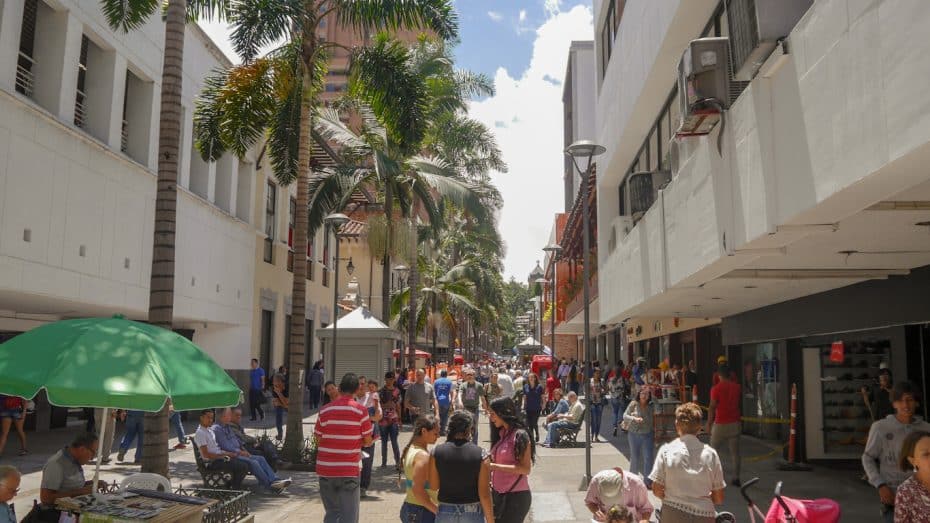
Calle Junín is a famous commercial street with a rich history dating back to the early 20th century. It officially became a pedestrian street in 1987, enhancing its social and commercial hub role.
Junín runs through Centro, from Parque de Bolívar to Avenida La Playa. Over the years, it has transformed into a melting pot of culture and commerce, home to landmarks like the historic Junín Theatre and the Coltejer Building, which, at 175 meters (574 ft), is Medellín’s tallest skyscraper.
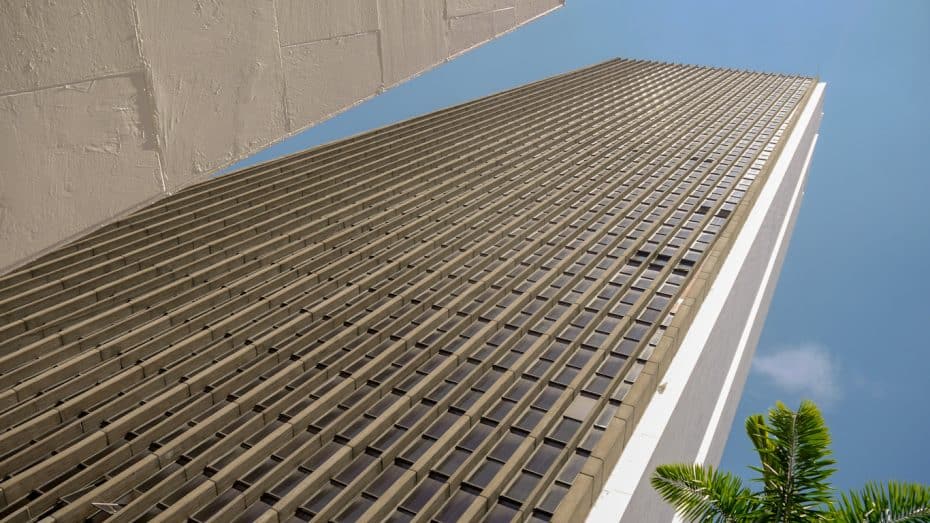
Calle Junín is renowned for its vibrant street life, with vendors selling everything from fresh fruit to handmade crafts. Noteworthy spots include Repostería Astor, a pastry shop established in 1930, and the Librería Nacional bookstore.
You can get to Junín Street through Parque Berrío Station on Line A and walk southwards.
8. Parque de los Pies Descalzos
Cra. 58 #42-125, La Candelaria, Medellín
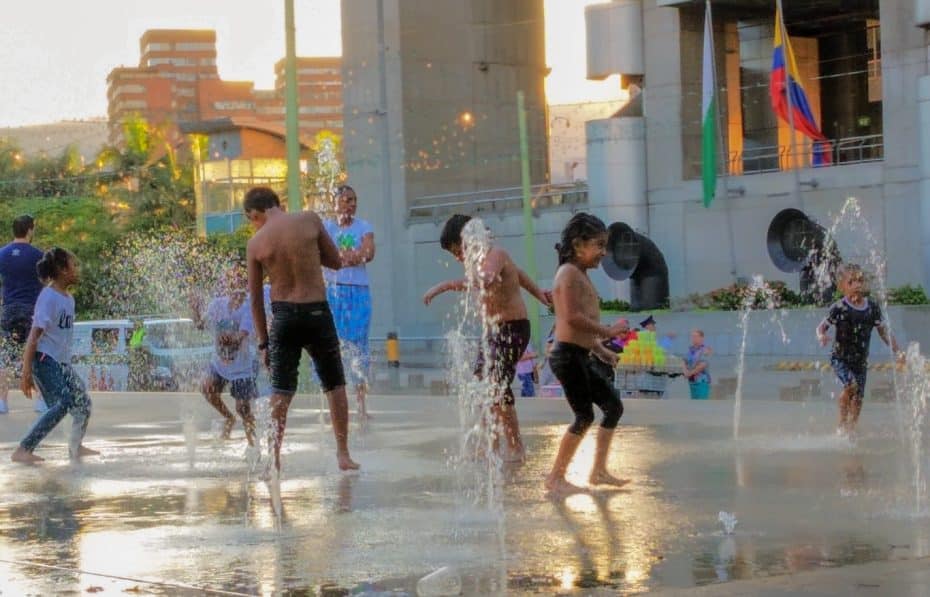
Parque de los Pies Descalzos, or Barefoot Park, is an interesting place to visit. It was opened in 1999 as part of the city’s urban revitalization and was designed by architect Felipe Uribe de Bedout. It’s located in the western part of Medellín’s La Candelaria area, directly adjacent to several important buildings, such as the EPM Library and the Water Museum.
The park is unique for its emphasis on sensory experiences. As its name suggests, it encourages visitors to walk barefoot through various textures, including sand, grass, and pebbles. One of the standout features is the water plaza with shallow pools and fountains, which are great for cooling off on a warm day.
10. Centro Comercial Palacio Nacional
Cra. 52 #48-45, La Candelaria, Medellín
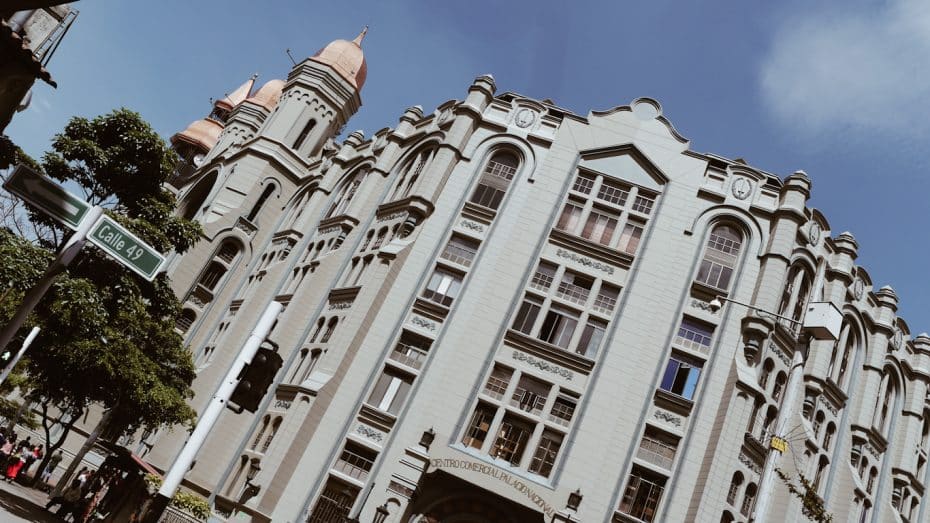
Arguably one of Latin America’s most beautiful shopping centers, Centro Comercial Palacio Nacional offers a fascinating and astounding history. Originally completed in 1923, this building initially served as the National Palace of Justice until it was transformed into a shopping center in the late 20th century.
The building’s architecture is a striking example of the Colombian Republican Neoclassical style. It was designed by the aforementioned Belgian architect Agustín Goovaerts, who left a significant mark on Medellín’s cityscape.
It features an imposing facade and grand interior.
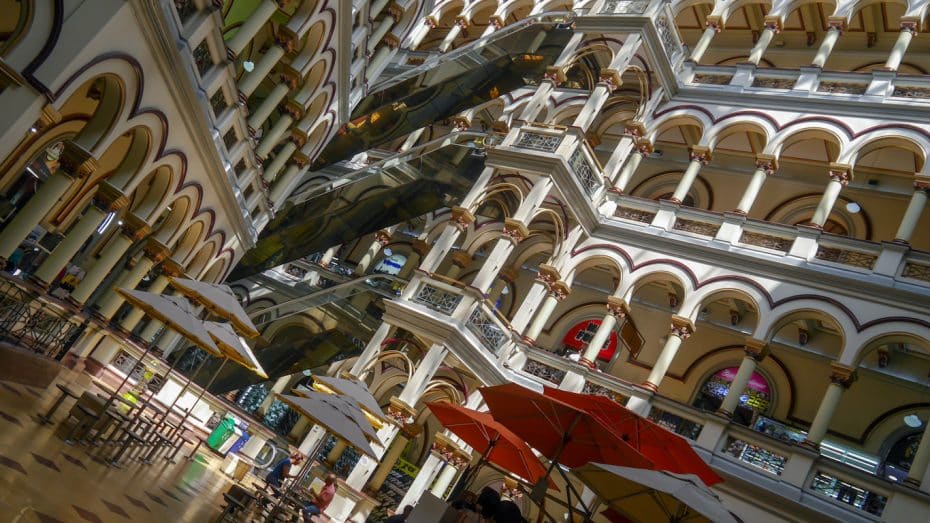
Palacio Nacional is near Parque Berrío station. This central location makes it easily accessible via public transport. The commercial center features specialized stores that range from electronics and apparel to artisanal crafts.
Personal opinion: While Medellín is home to several modern malls with international brands, Centro Comercial Palacio Nacional is unique not for its upscale shopping experience or luxury brands but for its breathtaking and historical architecture.
11. La Alpujarra Administrative Center
Cra. 57 # 41-81, La Candelaria, Medellín
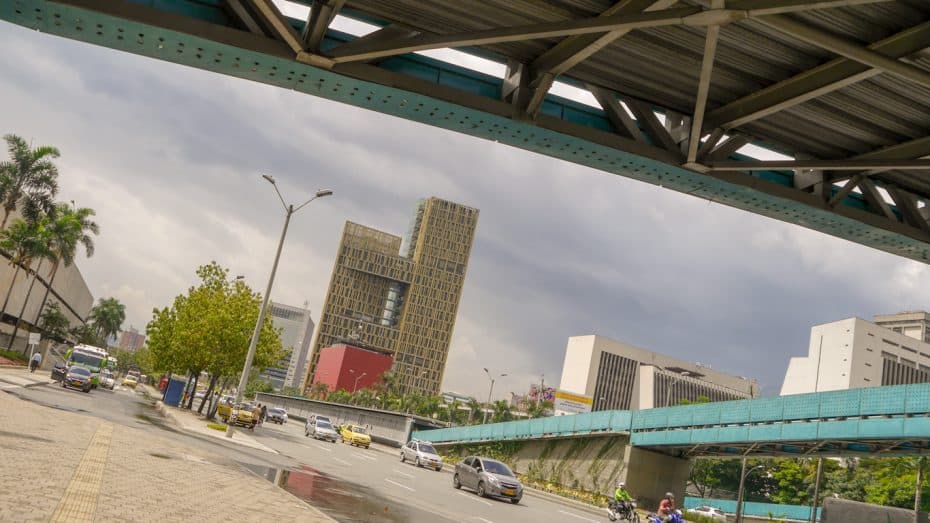
Centro Administrativo La Alpujarra is an important administrative and cultural hub in Medellín. Established during the urban renewal of the 1980s, this center stands as a significant point for governmental and administrative activities in the city. It is strategically located between Avenida San Juan and Avenida Ferrocarril, making it easily accessible.
Historically, the creation of La Alpujarra was part of a broader plan to consolidate various municipal and departmental offices into one centralized location and merge the traditionally upscale district of El Poblado and the historical working-class La Candelaria.
In case you missed it…
Among the key buildings here are the Antioquia Government Building and the Edificio EPM.
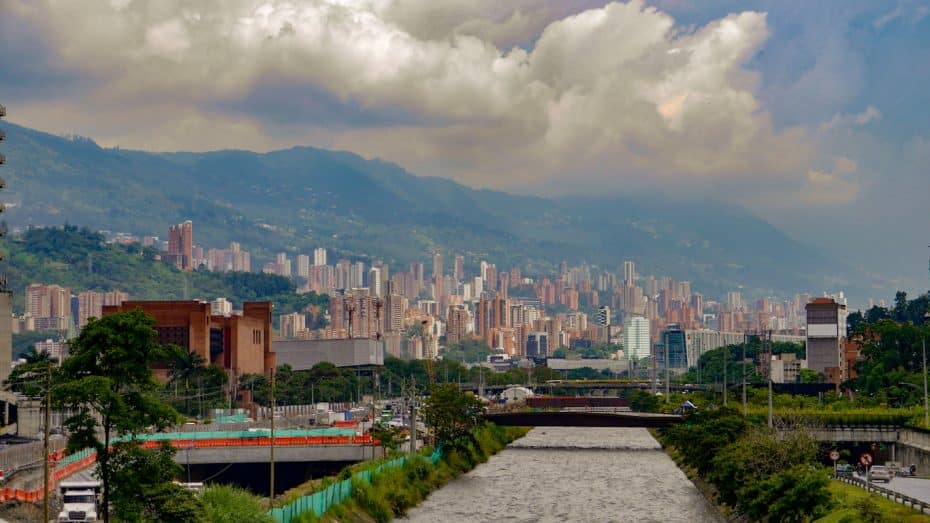
Getting to La Alpujarra is straightforward thanks to the Metro de Medellín Line A. Exposiciones Station is the closest metro stop. From there, it’s just a short walk to the administrative center.
Downtown Medellín: Transportation Guide
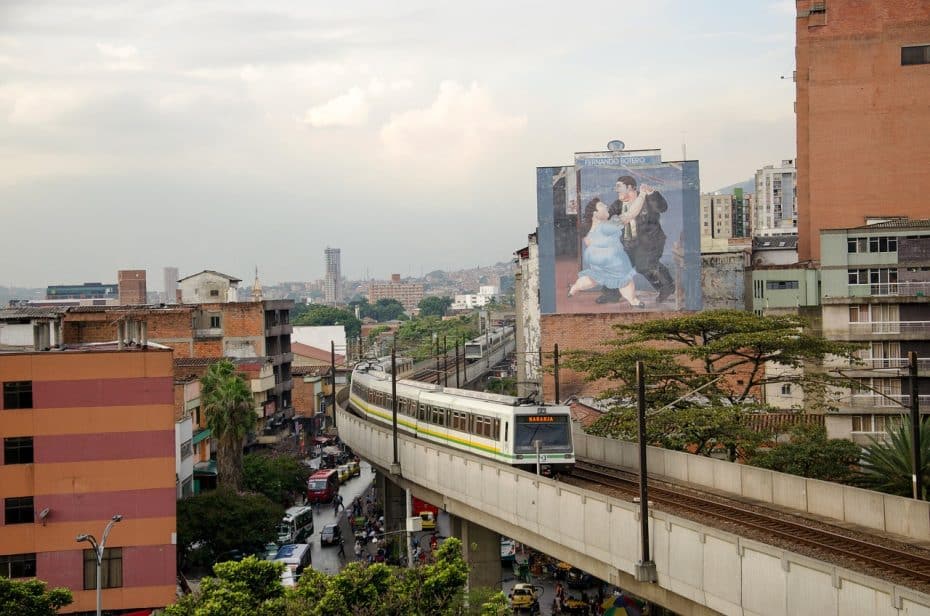
Medellín has a well-organized public transport system, making it relatively easy to navigate the city. The main component is the Metro de Medellín, which includes Line A and Line B.
Fun fact: Medellín was the first city in Colombia to inaugurate a metro system, back in 1995. In stark contrast, Bogotá’s metro is still under construction. In fact, Medellín’s subway system was the second-oldest metro system in northern South America after Caracas’ and the 8th oldest in Latin America.
These are some of the best options to get around Medellín City Center:
Metro
The Metro in Medellín began operations in the mid 1990 and has since become the backbone of urban mobility in the city. Comprising two main lines, Line A, which runs north to south, and Line B, which runes east to west, it connects a good portion of the city. As a tourist, some important stations to remember are Parque Berrío and Poblado on Línea A, and Laureles-Estadio on Línea B, as well as San Antonio, where Lines A and B intersect.
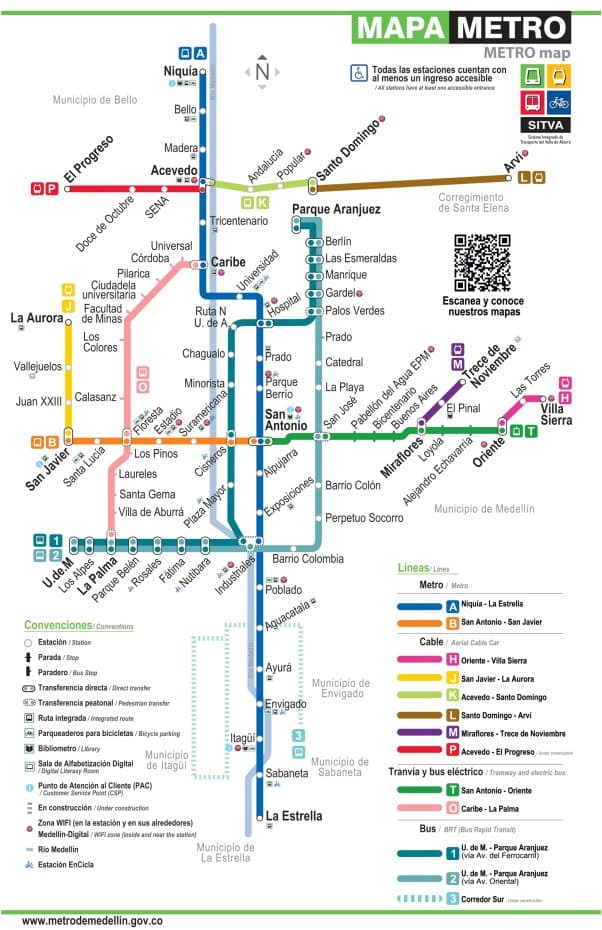
Widely considered one of the most efficient subway systems in Latin America, the metro is known for its punctuality, and the scenic views of the city it offers, as it’s mostly overground.
Tranvía de Medellín
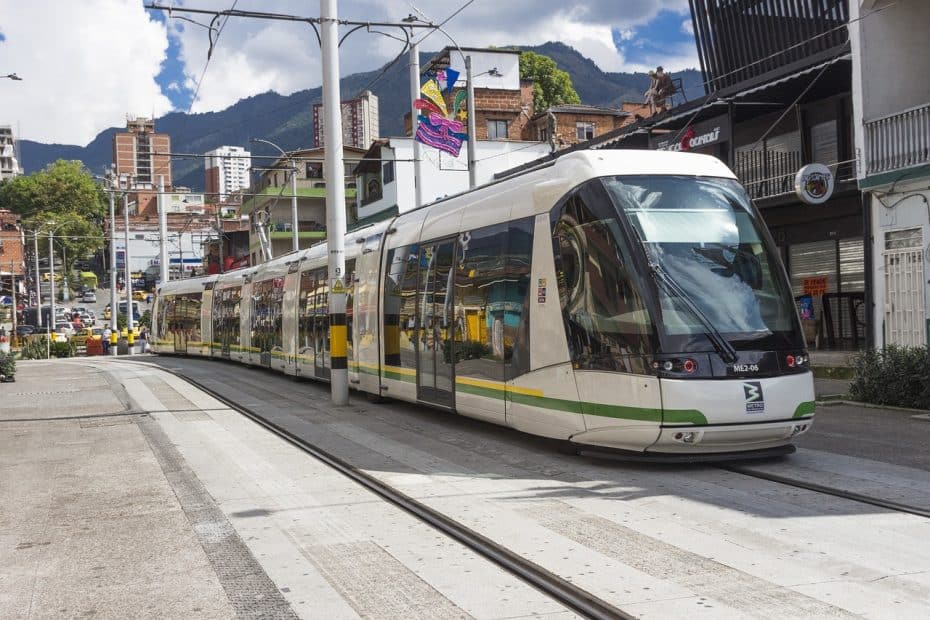
Medellín’s tram system is relatively new, opening in 2016 as an extension of the metro network. The tramway runs East-West across the central and eastern parts of the city. Main places to access the tram include San Antonio (main hub of the whole transport system where you can change to Metro lines A and B), Oriente Station and Miraflores Station (with connections to the city’s Metrocable).
Metroplus (BRT)
The Metroplus, a Bus Rapid Service, complements the Metro by using dedicated bus lanes to avoid traffic congestion. Lines L1 and O1 are the primary routes, running through key areas like Aranjuez and University City. These shuttle buses mainly reach areas that are not directly accessible by subway.
Metrocable de Medellín
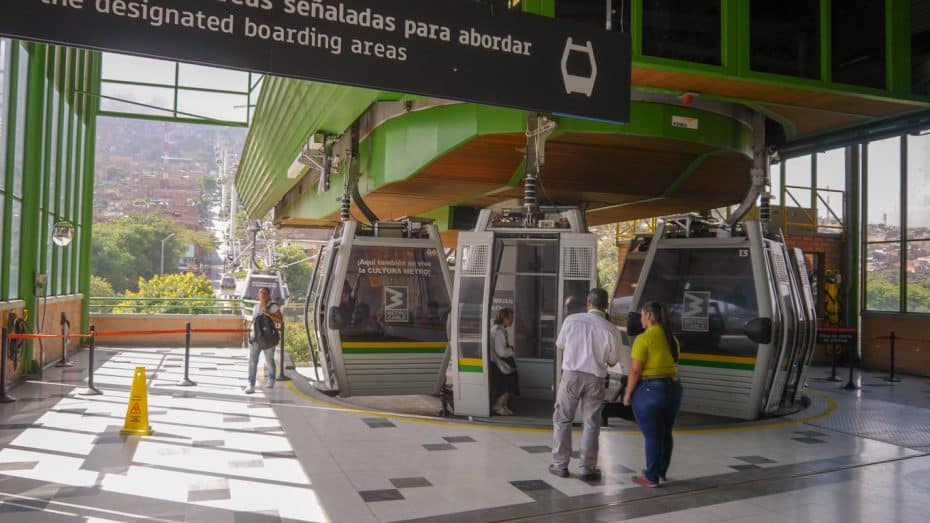
Medellín’s Metrocable is an innovative aerial cable car system designed specifically for hillside communities. Lines K, J, H, L, and M connect remote neighborhoods to the metro lines, essentially improving accessibility for residents in hilly areas. As a visitor, you will most likely use Line L, which takes passengers up to Parque Arví. This ecological park is located in the northeastern part of the city and offers hiking trails and picnic spots.
Interesting (and inspiring) fact: The Metrocable project, for which Medellín is a pioneer, has significantly contributed to urban regeneration by integrating marginalized neighborhoods into the urban economy.
The soaring trams have not only helped people get around more quickly and affordably, they’ve expanded access to opportunity and encouraged new public investments in previously neglected areas.
The initiative, initially met with skepticism, paid off by reducing the average rate of violent deaths by 66% between 2003 and 2008 in these areas because better access to the city brought more social integration.
Inspired by Medellín’s successes, other cities have implemented similar systems. Caracas opened its Metrocable system in 2010, serving the barrio of San Agustín. Meanwhile, La Paz’s Mi Teleférico opened in 2014, connecting major zones like El Alto and Zona Sur.
Urban Buses
Medellín also relies heavily on an extensive network of buses and microbuses known as busetas that reach nearly all corners of the city. Major bus terminals are located at Terminal del Norte and Terminal del Sur, providing connectivity for longer trips beyond city limits. Unlike Metroplus buses, local buses have different fares according to the line, and some aren’t included in the metro fare system.
Taxis and Mobile Apps
Taxis are easily available throughout Medellín with several reliable companies operating round-the-clock services. You can also use ride-hailing apps like Uber and Cabify for added convenience and security. Rates are reasonable compared to many other cities, and they’re an excellent way to cover short distances or reach destinations not serviced by public transit.
Where to Stay in Medellín City Center
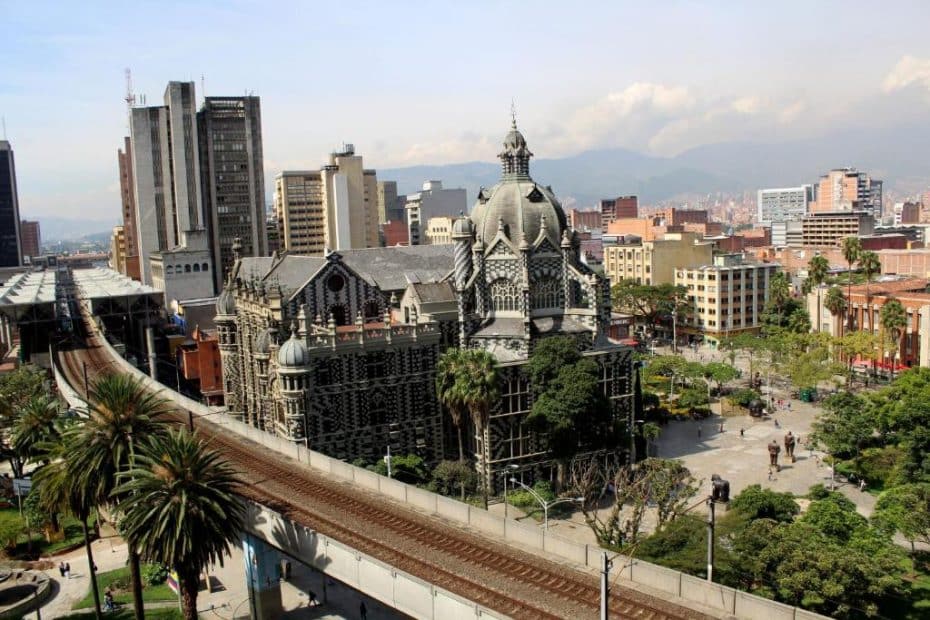
La Candelaria in Medellín is an excellent area to stay on a budget, as it’s generally much cheaper than areas like El Poblado. As previously mentioned, this historic district offers fascinating cultural sights. The neighborhood’s charm comes from its colonial buildings and vibrant street art. However, you should be cautious about safety, especially at night—some parts of Medellín Center can be unsafe after dark.
Best Hotels in Medellín City Center
In case you missed it…
Top Activities to Enjoy in Medellín City Center
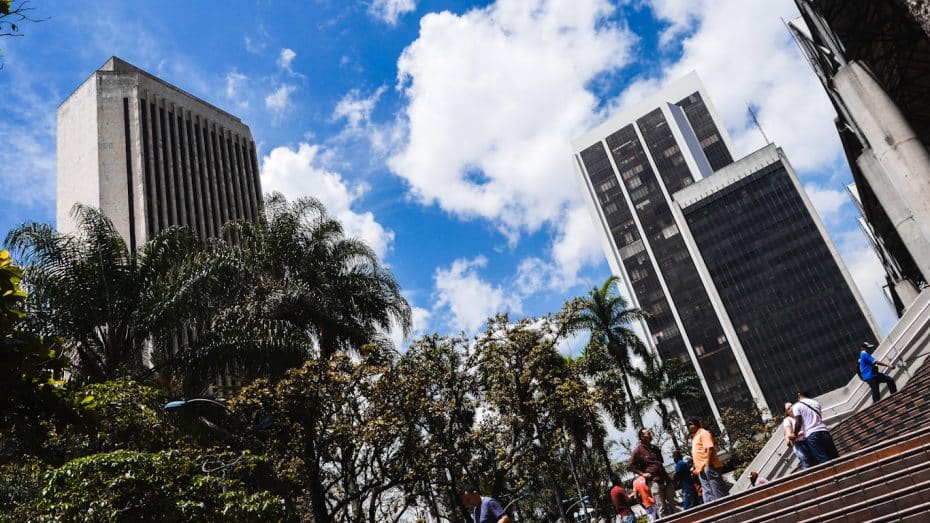
Medellín City Center offers many organized tours and activities for anyone visiting this vibrant area. Here’s a closer look at some top things to do:
Walking Tours and Sightseeing
Exploring the city center on foot reveals Medellín’s rich history and culture. Notable places include the Metropolitan Cathedral, Bolívar Park, and Plaza Botero. The nearby Museo de Antioquia provides insights into regional art and history. Many organized walking tours of La Candelaria focus on different aspects of the Colombian city. Here are some examples:
- City Tour Medellin, Comuna 13 & Graffiti Tour
- City Tour of Medellín
- Medellin City Private Tour
- Comuna 13 and Downtown Medellín Private City Tour
Food & Coffee Tours
For food lovers, El Poblado might be known for its nightlife, but the City Center will offer an authentic traditional taste of Paisa cuisine. Join a food tour and sample bandeja paisa, empanadas, and arepas in local markets like Placita de Flórez. Coffee enthusiasts can also book tours to learn about Colombia’s famous coffee production and culture. These are some of the best-rated food and coffee tours in Medellín:
- Food Tour in Medellin: An Authentic Culinary Experience
- Half-Day Bike Tour in Medellin – Local Food, Coffee & Beer
- Medellín Food Tour
- Coffee Tour and Lunch in Medellin
By the Way, Pablo Escobar Tours are NOT OK
Would you go on a tour glorifying the Columbine murderers or the legacy of the Gestapo? Well, visiting Pablo Escobar’s sites in Medellín is problematic for many reasons. While these tours might seem interesting to some, in part thanks to the popularity of shows like Narcos or Griselda, they trivialize the suffering and violence caused by Escobar’s operations. Some even are guided or include meeting characters of Pablo’s posse.
Since I’m not Colombian myself, I’ve translated this quote from Jessica Smith Soto for Matador Network in an article about how to get a Colombian person mad:
Many Colombians do not want to be associated with someone considered a disgrace to their country. Talking about [Escobar] is complicated. As a foreigner, you can’t ignore the damage the drug lord has caused…
Luckily, while many tours and attractions unashamedly glorify his life and “legacy,” others chose to focus instead on the devastation he caused and pay tribute to the victims of his reign of terror. Some of these include:
- Do Not Say That Name
- The Dark Days: Pablo Escobar and the New Medellin Private Tour
- We Don’t Talk About Pablo
In case you missed it…
Medellín City Center and Personal Safety
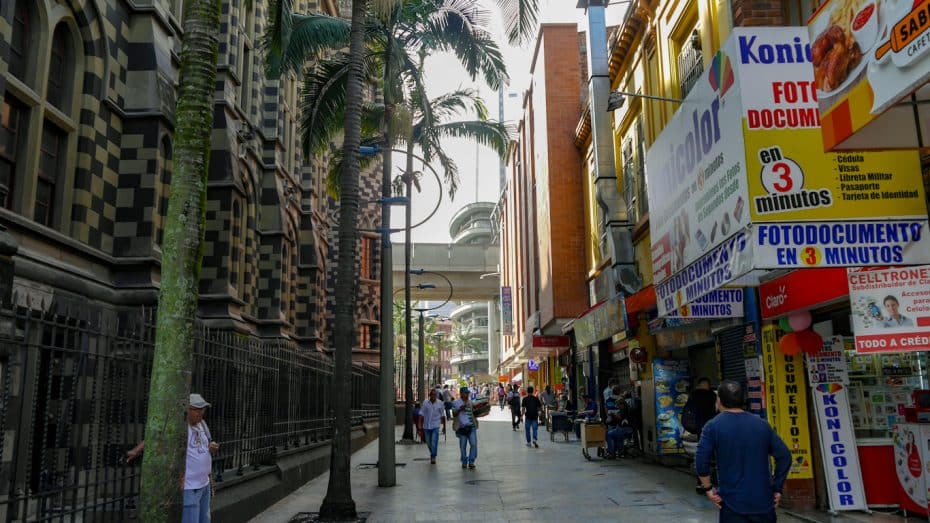
Medellín’s downtown district is a bustling place with numerous factors to consider regarding personal safety.
Personal take: I never felt unsafe in my six months there. That said, I am a male traveler, and while I’m not Colombian, my appearance does not immediately scream “foreigner” (as long as I don’t speak, lol). This afforded me some privileges. However, this can’t be generalized for everyone. Your personal experience might vary depending on a million factors.
So is La Candelaria safe? Well, yes and no. While most of downtown Medellín is perfectly safe during the day, it can be dicey at night. Avoid poorly lit and deserted areas after dark.
Gun violence and terrorism have decreased significantly since the late 1990s, and while it still happens, it’s mostly relegated to gangs operating in the most underprivileged barrios.
According to reports, most crimes in Medellín’s downtown today relate to pickpocketing and cellphone theft. This is especially true for crimes against visitors.
Medellín experienced a significant reduction in its homicide rate from the 1990s peak of 381 per 100,000 inhabitants to 26 per 100,000 inhabitants in 2019
While the local police presence is noticeable in busy areas (and exponentially more visible in El Poblado than La Candelaria), don’t rely entirely on them for protection. After dark, stick to the main streets and well-trafficked areas such as Parque de las Luces.
If you’re out enjoying the legendary Medellín nightlife, try using taxis and Ubers to move around, even if your accommodation is objectively nearby.
Female travelers should exercise additional caution in certain contexts. Since I can’t talk from experience, here’s what a fellow travel blogger (who’s female) has to say:
When you’re a woman traveling alone in Colombia, you will hear lots of anecdotes […]. There are women who […] will say, “Don’t worry, Colombia’s fine, nothing happened to me!” And then you’ll hear from other women who will say, “I know so many people who got robbed there.”
Stay informed about safety and specific risky areas by checking local news outlets, such as the expat news site MedellinGuru, and local newspapers like El Colombiano (in Spanish).
I can’t stress this fact enough: Public transportation serves La Candelaria very well, especially when compared to other Colombian cities. That said, foreign travelers are probably better off using reliable methods like registered taxis or ride-sharing services at night. Walking alone at night in downtown Medellín is not recommended.
Stick to well-lit paths and avoid displaying expensive items openly.
In summary, while La Candelaria has become much safer over recent years, caution is still necessary.
Nightlife in Medellín City Center
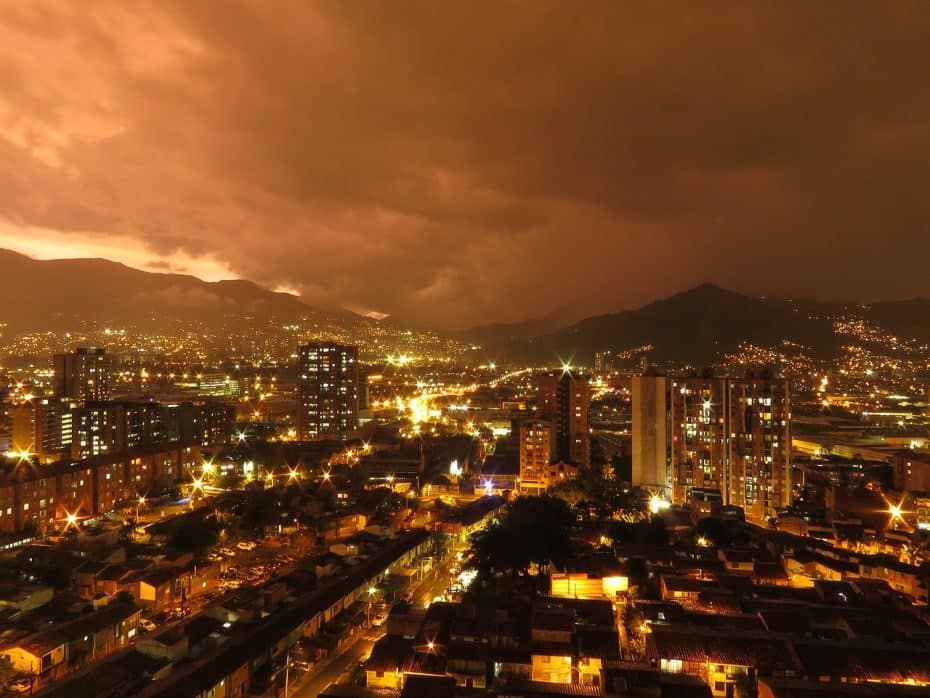
Medellín’s City Center and upscale El Poblado offer two very different nightlife experiences. While El Poblado is known for its fancy nightclubs and trendy bars, the City Center comes alive with a raw, energetic, and definitely more traditional vibe.
The City Center is famous for its fondas, traditional bars, and chivas. A fonda is an open-air bar often featuring traditional Colombian music, such as cumbia and vallenato, as well as dancing.
Personal take: Stripped of the frills and faux glamour of upscale, gringo-oriented venues, fondas have been around for years and offer a glimpse into Medellín’s (and Colombia’s) culture and impressive musical heritage.
On the other hand, chivas (literally “goats”) are old and colorful buses turned into mobile party vehicles. They roll through the streets with loud music blaring, people dancing on board, and drinks flowing freely.
The nightlife in the City Center also offers affordable drinks and food, making it popular among the younger crowd and those looking for an authentic Colombian experience.
Personal take: While nightlife in Medellín City Center is a unique way to “rumbear” like a Colombian, it’s also worth noting that fondas are best enjoyed when you’re already somewhat familiar with the culture and music, and/or if you have a local friend to guide you through the scene.
These are some nightlife places in La Candelaria that are worth visiting:
- Salon Malaga (Carrera 51 #45-80, Medellín)
- El Club del Jazz (Calle 54 #45-11, Medellín 050012 Colombia)
- Casa Cultural La Chispa (Calle 59 45 70, Medellín)



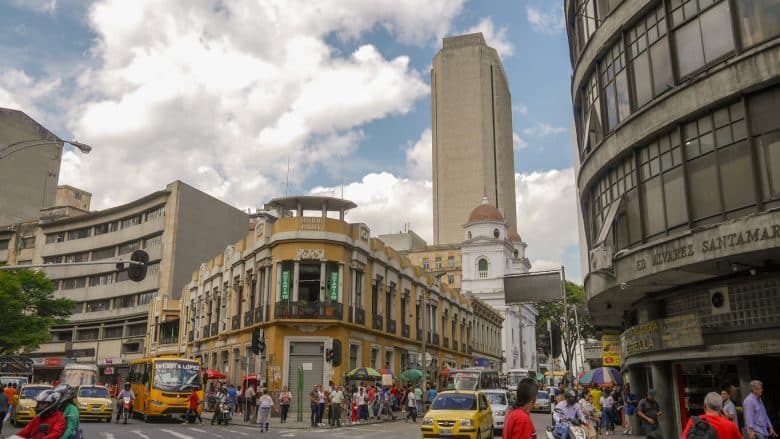



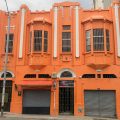

















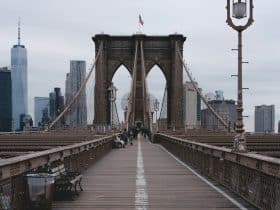
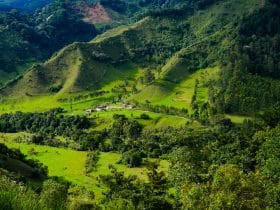

Leave a Reply
View Comments